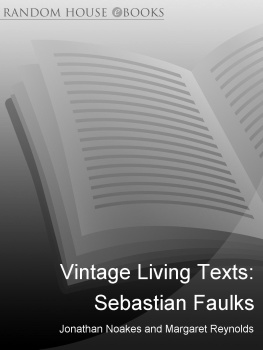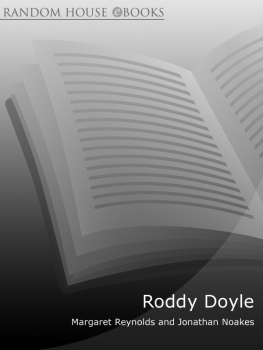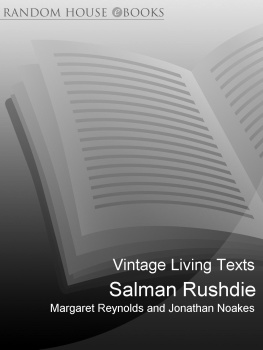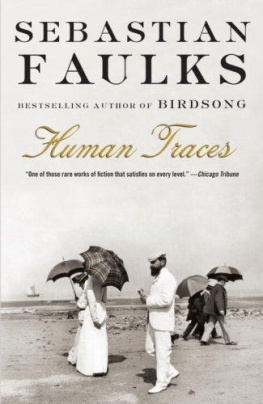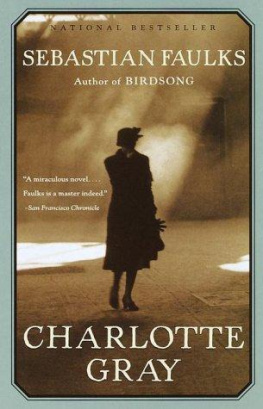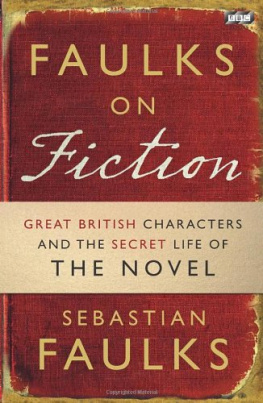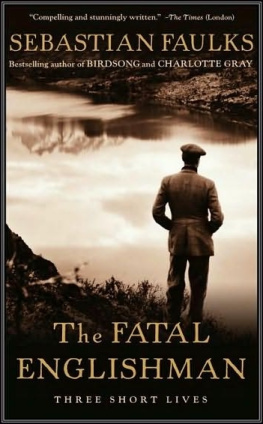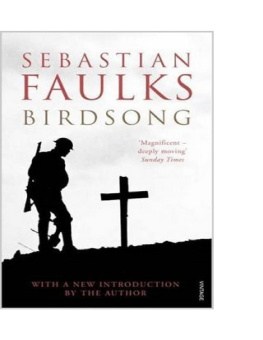CONTENTS
About the Authors
Jonathan Noakes has taught English in secondary schools in Britain and Australia for fifteen years. For six years he ran A-level English studies at Eton College where he is a house-master.
Margaret Reynolds is Reader in English at Queen Mary, University of London, and the presenter of BBC Radio 4s Adventures in Poetry. Her publications include The Sappho Companion and (with Angela Leighton) Victorian Women Poets.
About the Book
In Vintage Living Texts teachers and students will find the essential guide to the works of Sebastian Faulks. This guide will deal with his themes, genre and narrative technique, and a close reading of the texts will be accompanied with likely exam questions, and contexts and comparisons as well as providing a rich source of ideas for intelligent and inventive ways of approaching the novels.
Also available in Vintage Living Texts
Margaret Atwood
Focusing on
The Handmaids Tale
The Blind Assassin
Bluebeards Egg and Other Stories
Louis de Bernires
Focusing on
Captain Corellis Mandolin
The War of Don Emmanuels Nether Parts
Seor Vivo and the Coca Lord
The Troublesome Offspring of Cardinal Guzman
Ian McEwan
Focusing on
The Child in Time
Enduring Love
Atonement
Vintage Living Texts: Sebastian Faulks
The Essential Guide to Contemporary Literature
Jonathan Noakes and Margaret Reynolds
Birdsong
Charlotte Gray
The Girl at the Lion dOr

VINTAGE LIVING TEXTS
Preface
About this series
VINTAGE LIVING TEXTS:The Essential Guide to Contemporary Literature is a new concept in reading guides. Our aim is to provide readers of all kinds with an intelligent and accessible introduction to key works of contemporary literature. Each guide suggests techniques for reading important contemporary novels, and offers a variety of back-up materials that will give you ways into the text without ever telling you what to think.
Content
All the books reproduce an extensive interview with the author, conducted exclusively for this series. This is not to say that we believe that the authors word is law. Of course it isnt. Once his or her book has gone out into the world he or she becomes simply yet another if singularly competent reader. This series recognises that an authors contribution may be valuable, and intriguing, but it puts the reader in control.
Every title in the series is author-focused and covers at least three of their novels, along with relevant biographical, bibliographical, contextual and comparative material.
How to use this series
In the reading activities that make up the core of each book you will see that you are asked to do two things. One comes from the text; that is, we suggest what you should focus on, whether its a theme, the language or the narrative method. The other concentrates on your own response. We want you to think about how you are reading and what skills you are bringing to bear in doing that reading. So this part is very much about you, the reader.
The point is that there are many ways of responding to a text. You could concentrate on the methods you might use to compare this text with others. In that case, look for the sections headed Compare. Or you might want to do something more individual, and analyse how you are reacting to a text and what it means to you, in which case, pick out the approaches labelled Imagine or Ask Yourself.
Of course, it may well be that you are reading these texts for an exam. In that case you will have to go for the more traditional methods of literary criticism and look for the responses that tell you to Discuss or Analyse. Whichever level you (or your students) are at, you will find that there is something here for everyone. But were not suggesting that you stick solely to the approaches we offer, or that you tackle all of the exercises laid out here. Choose whatever most interests you, or whatever best suits your purposes.
Who are these books for?
Students will find that these guides are like a good teacher. They introduce the life and work of the author, set each novel in its context, explain key ideas and literary critical terms as they arise, suggest comparative exercises in a number of media, and ask focused questions to encourage a well-informed, analytical approach to reading the novels in a way that is rigorous, but still entertaining.
Teachers will find in this series a rich source of ideas for teaching contemporary novels and their contexts, particularly at AS, A and undergraduate level. The exercises on each text have been tailored to meet the various assessment objectives laid down in the subject criteria for GCE AS and GCE A Level English Literature, and are explained in such a way that they can easily be selected and fitted into a lesson plan. Given the diversity of ways in which the awarding bodies have devised their specifications to meet these assessment objectives, a wide range of exercises is offered. Weve had fun devising the plans, and we hope theyll be fun for you when you come to teach and learn with them.
And if you are neither a teacher nor a student of contemporary literature, but someone reading for your own pleasure? Well, if youve ever wanted someone to introduce you to a novelists work in a way that will let you trust your own judgement and read more confidently, then this guide is also for you.
Whoever you are, we hope that you will enjoy using these books and that they will send you back to the novels to find new pleasures.
All page references in this text refer to the Vintage edition.
Sebastian Faulks
Introduction
WHEN WE INTERVIEWED Sebastian Faulks for this book we asked him a question about letters. Why was it that so many letters in his novels were misdirected, misdelivered, failed to reach the right person, were not read by the right person and in some cases were only imagined, so that they never even got written in the first place? As youll see if you look this question up, Faulks was not even sure what we were talking about. He hadnt noticed all these lost letters.
Of course there are also many letters that do get sent and do get read. But these thwarted missives suggest something telling about the preoccupations in Faulkss novels and hint at a number of his themes. In one way its not surprising that there are so many letters in Faulks, because the device of using letters in novels and inserting their text into the narrative is one that makes for solidity a pretend concrete reality. This is what this character said to this other character, without the mediation of the narrating voice or the intervention of any other characters perspective. The author has created made up this letter, but we are willing temporarily to believe in its existence and its truth as an imaginative reality.
Many critics and reviewers have commented on Faulkss ability to create an imagined world that seems to have a solid existence. He does this by doing an extensive amount of historical research, as his Authors Note to Charlotte Gray tells us. As a result, reviewers like to play the spot the error game with Faulkss books. Sometimes they do find tiny discrepancies. Sometimes they think they know more about the past that they imagine they remember, than they do about the past that Faulks has recovered through research. When he was writing
Next page
